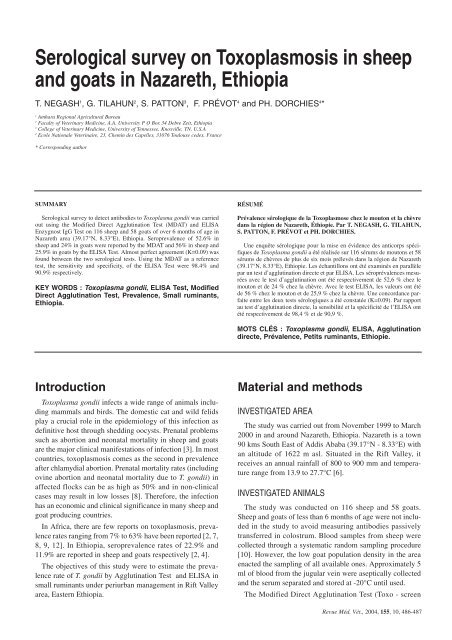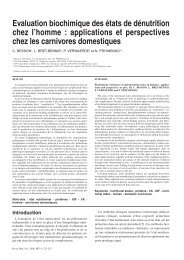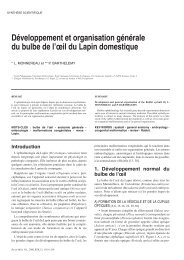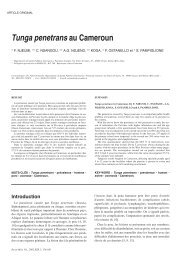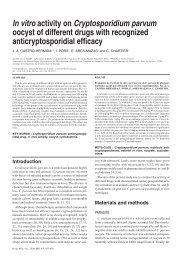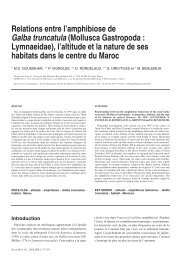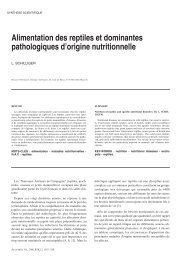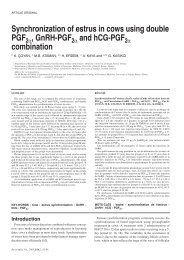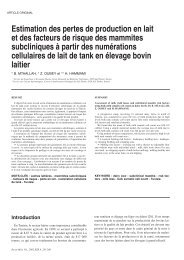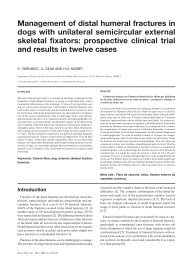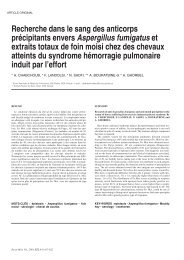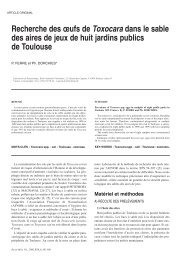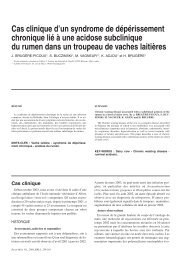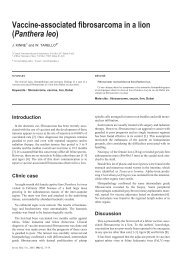Serological survey on Toxoplasmosis in sheep and goats in ...
Serological survey on Toxoplasmosis in sheep and goats in ...
Serological survey on Toxoplasmosis in sheep and goats in ...
Create successful ePaper yourself
Turn your PDF publications into a flip-book with our unique Google optimized e-Paper software.
<str<strong>on</strong>g>Serological</str<strong>on</strong>g> <str<strong>on</strong>g>survey</str<strong>on</strong>g> <strong>on</strong> <strong>Toxoplasmosis</strong> <strong>in</strong> <strong>sheep</strong><br />
<strong>and</strong> <strong>goats</strong> <strong>in</strong> Nazareth, Ethiopia<br />
T. NEGASH 1 , G. TILAHUN 2 , S. PATTON 3 , F. PRÉVOT 4 <strong>and</strong> PH. DORCHIES 4 *<br />
1<br />
Amhara Regi<strong>on</strong>al Agricultural Bureau<br />
2<br />
Faculty of Veter<strong>in</strong>ary Medic<strong>in</strong>e, A.A. University P O Box 34 Debre Zeit, Ethiopia<br />
3<br />
College of Veter<strong>in</strong>ary Medic<strong>in</strong>e, University of Tennessee, Knoxville, TN, U.S.A<br />
4<br />
Ecole Nati<strong>on</strong>ale Veter<strong>in</strong>aire, 23, Chem<strong>in</strong> des Capelles, 31076 Toulouse cedex, France<br />
* Corresp<strong>on</strong>d<strong>in</strong>g author<br />
SUMMARY<br />
<str<strong>on</strong>g>Serological</str<strong>on</strong>g> <str<strong>on</strong>g>survey</str<strong>on</strong>g> to detect antibodies to Toxoplasma g<strong>on</strong>dii was carried<br />
out us<strong>in</strong>g the Modified Direct Agglut<strong>in</strong>ati<strong>on</strong> Test (MDAT) <strong>and</strong> ELISA<br />
Enzygnost IgG Test <strong>on</strong> 116 <strong>sheep</strong> <strong>and</strong> 58 <strong>goats</strong> of over 6 m<strong>on</strong>ths of age <strong>in</strong><br />
Nazareth area (39.17°N, 8.33°E), Ethiopia. Seroprevalence of 52.6% <strong>in</strong><br />
<strong>sheep</strong> <strong>and</strong> 24% <strong>in</strong> <strong>goats</strong> were reported by the MDAT <strong>and</strong> 56% <strong>in</strong> <strong>sheep</strong> <strong>and</strong><br />
25.9% <strong>in</strong> <strong>goats</strong> by the ELISA Test. Almost perfect agreement (K=0.09) was<br />
found between the two serological tests. Us<strong>in</strong>g the MDAT as a reference<br />
test, the sensitivity <strong>and</strong> specificity, of the ELISA Test were 98.4% <strong>and</strong><br />
90.9% respectively.<br />
KEY WORDS : Toxoplasma g<strong>on</strong>dii, ELISA Test, Modified<br />
Direct Agglut<strong>in</strong>ati<strong>on</strong> Test, Prevalence, Small rum<strong>in</strong>ants,<br />
Ethiopia.<br />
RÉSUMÉ<br />
Prévalence sérologique de la Toxoplasmose chez le mout<strong>on</strong> et la chèvre<br />
dans la régi<strong>on</strong> de Nazareth, Éthiopie. Par T. NEGASH, G. TILAHUN,<br />
S. PATTON, F. PRÉVOT et PH. DORCHIES.<br />
Une enquête sérologique pour la mise en évidence des anticorps spécifiques<br />
de Toxoplasma g<strong>on</strong>dii a été réalisée sur 116 sérums de mout<strong>on</strong>s et 58<br />
sérums de chèvres de plus de six mois prélevés dans la régi<strong>on</strong> de Nazareth<br />
(39.17°N, 8.33°E), Ethiopie. Les échantill<strong>on</strong>s <strong>on</strong>t été exam<strong>in</strong>és en parallèle<br />
par un test d’agglut<strong>in</strong>ati<strong>on</strong> directe et par ELISA. Les séroprévalences mesurées<br />
avec le test d’agglut<strong>in</strong>ati<strong>on</strong> <strong>on</strong>t été respectivement de 52,6 % chez le<br />
mout<strong>on</strong> et de 24 % chez la chèvre. Avec le test ELISA, les valeurs <strong>on</strong>t été<br />
de 56 % chez le mout<strong>on</strong> et de 25,9 % chez la chèvre. Une c<strong>on</strong>cordance parfaite<br />
entre les deux tests sérologiques a été c<strong>on</strong>statée (K=0.09). Par rapport<br />
au test d’agglut<strong>in</strong>ati<strong>on</strong> directe, la sensibilité et la spécificité de l’ELISA <strong>on</strong>t<br />
été respectivement de 98,4 % et de 90,9 %.<br />
MOTS CLÉS : Toxoplasma g<strong>on</strong>dii, ELISA, Agglut<strong>in</strong>ati<strong>on</strong><br />
directe, Prévalence, Petits rum<strong>in</strong>ants, Ethiopie.<br />
Introducti<strong>on</strong><br />
Toxoplasma g<strong>on</strong>dii <strong>in</strong>fects a wide range of animals <strong>in</strong>clud<strong>in</strong>g<br />
mammals <strong>and</strong> birds. The domestic cat <strong>and</strong> wild felids<br />
play a crucial role <strong>in</strong> the epidemiology of this <strong>in</strong>fecti<strong>on</strong> as<br />
def<strong>in</strong>itive host through shedd<strong>in</strong>g oocysts. Prenatal problems<br />
such as aborti<strong>on</strong> <strong>and</strong> ne<strong>on</strong>atal mortality <strong>in</strong> <strong>sheep</strong> <strong>and</strong> <strong>goats</strong><br />
are the major cl<strong>in</strong>ical manifestati<strong>on</strong>s of <strong>in</strong>fecti<strong>on</strong> [3]. In most<br />
countries, toxoplasmosis comes as the sec<strong>on</strong>d <strong>in</strong> prevalence<br />
after chlamydial aborti<strong>on</strong>. Prenatal mortality rates (<strong>in</strong>clud<strong>in</strong>g<br />
ov<strong>in</strong>e aborti<strong>on</strong> <strong>and</strong> ne<strong>on</strong>atal mortality due to T. g<strong>on</strong>dii) <strong>in</strong><br />
affected flocks can be as high as 50% <strong>and</strong> <strong>in</strong> n<strong>on</strong>-cl<strong>in</strong>ical<br />
cases may result <strong>in</strong> low losses [8]. Therefore, the <strong>in</strong>fecti<strong>on</strong><br />
has an ec<strong>on</strong>omic <strong>and</strong> cl<strong>in</strong>ical significance <strong>in</strong> many <strong>sheep</strong> <strong>and</strong><br />
goat produc<strong>in</strong>g countries.<br />
In Africa, there are few reports <strong>on</strong> toxoplasmosis, prevalence<br />
rates rang<strong>in</strong>g from 7% to 63% have been reported [2, 7,<br />
8, 9, 12]. In Ethiopia, seroprevalence rates of 22.9% <strong>and</strong><br />
11.9% are reported <strong>in</strong> <strong>sheep</strong> <strong>and</strong> <strong>goats</strong> respectively [2, 4].<br />
The objectives of this study were to estimate the prevalence<br />
rate of T. g<strong>on</strong>dii by Agglut<strong>in</strong>ati<strong>on</strong> Test <strong>and</strong> ELISA <strong>in</strong><br />
small rum<strong>in</strong>ants under periurban management <strong>in</strong> Rift Valley<br />
area, Eastern Ethiopia.<br />
Material <strong>and</strong> methods<br />
INVESTIGATED AREA<br />
The study was carried out from November 1999 to March<br />
2000 <strong>in</strong> <strong>and</strong> around Nazareth, Ethiopia. Nazareth is a town<br />
90 kms South East of Addis Ababa (39.17°N - 8.33°E) with<br />
an altitude of 1622 m asl. Situated <strong>in</strong> the Rift Valley, it<br />
receives an annual ra<strong>in</strong>fall of 800 to 900 mm <strong>and</strong> temperature<br />
range from 13.9 to 27.7°C [6].<br />
INVESTIGATED ANIMALS<br />
The study was c<strong>on</strong>ducted <strong>on</strong> 116 <strong>sheep</strong> <strong>and</strong> 58 <strong>goats</strong>.<br />
Sheep <strong>and</strong> <strong>goats</strong> of less than 6 m<strong>on</strong>ths of age were not <strong>in</strong>cluded<br />
<strong>in</strong> the study to avoid measur<strong>in</strong>g antibodies passively<br />
transferred <strong>in</strong> colostrum. Blood samples from <strong>sheep</strong> were<br />
collected through a systematic r<strong>and</strong>om sampl<strong>in</strong>g procedure<br />
[10]. However, the low goat populati<strong>on</strong> density <strong>in</strong> the area<br />
enacted the sampl<strong>in</strong>g of all available <strong>on</strong>es. Approximately 5<br />
ml of blood from the jugular ve<strong>in</strong> were aseptically collected<br />
<strong>and</strong> the serum separated <strong>and</strong> stored at -20°C until used.<br />
The Modified Direct Agglut<strong>in</strong>ati<strong>on</strong> Test (Toxo - screen<br />
Revue Méd. Vét., 2004, 155, 10, 486-487
SEROLOGICAL SURVEY ON TOXOPLASMOSIS IN SHEEP AND GOATS IN NAZARETH 487<br />
DA, Dace Behr<strong>in</strong>g Marburg GmBH, Germany) <strong>and</strong> the<br />
ELISA (Enzygnost Bio Merieux, SA, Ly<strong>on</strong>, France)<br />
<strong>Toxoplasmosis</strong> /IgG Enzyme test were c<strong>on</strong>ducted accord<strong>in</strong>g<br />
to the manufacturers’ recomm<strong>and</strong>ati<strong>on</strong>s.<br />
STATISTICAL ANALYSIS<br />
Kappa statistic test was used to test the agreement between<br />
the two serological tests. It is def<strong>in</strong>ed as the excess agreement<br />
that expected by chance, divided by the potential<br />
excess. Kappa values of greater than 0.81: almost perfect<br />
agreement, 0.6 - 0.80: substantial agreement 0.41 - 0.06<br />
moderate agreement, 0.21 - 0.09: fair agreement; 0 - 0.2<br />
slight agreement <strong>and</strong> 0: poor agreement [10].<br />
Results<br />
Out of 116 ov<strong>in</strong>e serum samples 61(52.6%) <strong>and</strong> 65(56%)<br />
were positive with MDAT <strong>and</strong> ELISA Test respectively<br />
(Table I). There is no statistically significant difference between<br />
the results of the two tests as they detected similar proporti<strong>on</strong><br />
of positive serum samples. Test agreement bey<strong>on</strong>d<br />
chance between the two tests was K=0.90 <strong>and</strong> <strong>in</strong>dicates<br />
almost a perfect agreement. Us<strong>in</strong>g the MDAT as a reference<br />
test, the sensitivity <strong>and</strong> specificity of the Enzygnost Test<br />
were 98.9% <strong>and</strong> 90.9%.<br />
Seroprevalence for the 58 goat samples was 24.1% (14/58)<br />
by the MDAT <strong>and</strong> 25.9% (15/58) by the ELISA have been<br />
observed (data not shown).<br />
TABLE I. — Comparis<strong>on</strong> of the MDAT <strong>and</strong> Enzygnost tests for the detecti<strong>on</strong><br />
of anti-Toxoplasma g<strong>on</strong>dii IgG antibodies <strong>in</strong> <strong>sheep</strong>.<br />
Discussi<strong>on</strong><br />
The results of this work further c<strong>on</strong>firm the presence of T.<br />
g<strong>on</strong>dii <strong>in</strong>fecti<strong>on</strong> <strong>in</strong> <strong>sheep</strong> <strong>and</strong> goat populati<strong>on</strong>s <strong>in</strong> Ethiopia.<br />
The difference <strong>in</strong> seroprevalence <strong>in</strong>fecti<strong>on</strong> <strong>in</strong> <strong>sheep</strong> <strong>and</strong><br />
<strong>goats</strong> between the present work <strong>and</strong> the previous reports<br />
from Ethiopia may be attributed to difference of serological<br />
methods <strong>and</strong> <strong>in</strong> localities where samples have been d<strong>on</strong>e,<br />
because there are numerous eco-climatic areas <strong>in</strong> this country.<br />
Toxoplasma seroprevalence is variable, higher prevalence<br />
be<strong>in</strong>g observed <strong>in</strong> warm <strong>and</strong> moist areas than <strong>in</strong> cold or<br />
hot dry areas [2]. Apart from this, variati<strong>on</strong> may also be related<br />
to the age of the animals sampled <strong>and</strong> husb<strong>and</strong>ary practices.<br />
The overall prevalence recorded <strong>in</strong> <strong>sheep</strong> <strong>in</strong> the present<br />
work is higher (54.7%) compared to the previous reports<br />
from Ethiopia <strong>and</strong> other African countries. Prevalence rates<br />
rang<strong>in</strong>g from 11.5% to 39% have been recorded <strong>in</strong> various<br />
African countries <strong>in</strong>clud<strong>in</strong>g Ethiopia [2, 4, 8, 11, 12]. A still<br />
wider spectrum of seroc<strong>on</strong>versi<strong>on</strong> rate from 21% of <strong>sheep</strong><br />
sera <strong>in</strong> Brazil [5] to 88.7% <strong>in</strong> Cankiri, Turkey [1] have been<br />
recorded.<br />
The overall seroprevalence of 26.7% recorded <strong>in</strong> <strong>goats</strong> <strong>in</strong><br />
the present study is higher than those reported earlier from<br />
Ethiopia [2, 4]. In other African countries, <strong>in</strong>fecti<strong>on</strong> rates<br />
reported are higher : 31,9 % <strong>in</strong> Tanzania [11] <strong>and</strong> 63 % <strong>in</strong> the<br />
Sudan [12].<br />
The MDAT <strong>and</strong> ELISA Tests detected similar proporti<strong>on</strong><br />
of Toxoplasma positive serum samples. Therefore, both are<br />
reliable for populati<strong>on</strong> screen<strong>in</strong>g tests. However, both tests<br />
have their own advantages <strong>and</strong> limitati<strong>on</strong>s. The need for species<br />
specific c<strong>on</strong>jugates, <strong>and</strong> automatic processor to <strong>in</strong>crease<br />
the efficacy <strong>and</strong> spectrophotometer for quantify<strong>in</strong>g the activity<br />
of antibodies by ELISA Test may limit its use. On the<br />
other h<strong>and</strong>, the MDAT is safe <strong>and</strong> does not require species<br />
specific c<strong>on</strong>jugate <strong>and</strong> can be used <strong>on</strong> any species.<br />
Furthermore, the perfect agreement between the two tests as<br />
expla<strong>in</strong>ed by good k-value, suggests the use of <strong>on</strong>e procedure<br />
over the other depend<strong>in</strong>g <strong>on</strong> the choice of the <strong>in</strong>vestigator<br />
<strong>and</strong> availability of equipment.<br />
Aknowledgements<br />
The technical support of Ato Girmay Medh<strong>in</strong> <strong>in</strong> analyz<strong>in</strong>g<br />
the data is gratefully acknowledged. Mrs. Meliha Reshid<br />
k<strong>in</strong>dly typed the manuscript.<br />
References<br />
1. — BABUR C., INCI A., KARAER Z. : Detecti<strong>on</strong> of T. g<strong>on</strong>dii seropositivity<br />
<strong>in</strong> <strong>sheep</strong> <strong>and</strong> <strong>goats</strong> around Cankiri, Turkey us<strong>in</strong>g SFT. Act.<br />
Parasito. Turcica. 1997, 21, 409-412.<br />
2. — DECONINCK P., PANGUI L.G., AKAKPO J., GARROUSTE A.,<br />
QUATTARA L. ROGER F., TIBAYRENC R., DORCHIES P. :<br />
Prevalence of toxoplasmosis <strong>in</strong> small rum<strong>in</strong>ants <strong>in</strong> Tropical Africa.<br />
Results of seroepidemiological <str<strong>on</strong>g>survey</str<strong>on</strong>g>. Revue Méd. Vet. 1996, 147,<br />
377-378.<br />
3. — DUBEY J.P., WELCOME F.L. : Toxoplasma g<strong>on</strong>dii <strong>in</strong>duced aborti<strong>on</strong>s<br />
<strong>in</strong> <strong>sheep</strong>. JAVMA, 1988, 193, 698-700.<br />
4. — BEKELE T., KASALI O.B. : <strong>Toxoplasmosis</strong> <strong>in</strong> <strong>sheep</strong>, <strong>goats</strong> <strong>and</strong><br />
cattle <strong>in</strong> Central Ethiopia. Vet. Res. Commun. 1989, 13, 371-375.<br />
5. — MARTINS J.R.,, HANCOCK R., CORREA B.L, CERESER V.H. :<br />
Occurrence of antibodies to Toxoplasma g<strong>on</strong>dii <strong>in</strong> <strong>sheep</strong> <strong>in</strong> the district<br />
of Livramenta, Rio Gr<strong>and</strong>e do Sul, Brazil. Pesq. Agr. Pec.<br />
Gauch. 1998. 4, 27-29.<br />
6. — Nati<strong>on</strong>al Meteorological Service Agency, Addis Ababa, Ethiopia.<br />
1999<br />
7. — OKOH A.E.J., AGBONLAHOR D.E., MOMOH M. :<br />
<strong>Toxoplasmosis</strong> <strong>in</strong> Nigeria: A serological <str<strong>on</strong>g>survey</str<strong>on</strong>g>. Trop. Anim. Hlth.<br />
Prod. 1981, 13, 137-143.<br />
8. — RADOSTITS O.M., BLOOD, D.C., GAY C.C. : A textbook of the<br />
disease of cattle, <strong>sheep</strong>, pigs, <strong>goats</strong> <strong>and</strong> horses. 8 th ed. W.B.<br />
Saunders, L<strong>on</strong>d<strong>on</strong>. 1994<br />
9. — SINGH B., MOSLLA P.: Seroprevalence <strong>and</strong> Pathogenesis of<br />
Toxoplasma g<strong>on</strong>dii <strong>in</strong> <strong>sheep</strong> <strong>and</strong> <strong>goats</strong> <strong>in</strong> tropical regi<strong>on</strong>s. In:<br />
Proceed<strong>in</strong>gs of the Sec<strong>on</strong>d Tanzania Veter<strong>in</strong>ary Associati<strong>on</strong><br />
Scientific C<strong>on</strong>ference. J. Tanz. Vet. Assoc. 1984, 2, 210-216.<br />
10. — THRUSFIELD M. : Veter<strong>in</strong>ary Epidemiology, 2 nd ed. Blackwell<br />
Science Ltd. U.K. 1995.<br />
11. —WILSON M., WARE D.A., JURANEK D.D. Serologic aspects of<br />
toxoplasmosis . JAVMA 1990, 196, 277-278.<br />
12. — ZAIN ELDIN E.A., ELKHAWAD S.E.,.KHEIR H.S.M. : A serologic<br />
<str<strong>on</strong>g>survey</str<strong>on</strong>g> for Toxoplasma antibodies <strong>in</strong> cattle, <strong>sheep</strong>, <strong>goats</strong> <strong>and</strong><br />
camels. (Camelus dromedarius) <strong>in</strong> the Sudan. Rev. Elev. Med. Pays.<br />
Trop. 1985. 38, 247-249.<br />
Revue Méd. Vét., 2004, 155, 10, 486-487


